
Posted on 02/20/2012 4:34:48 AM PST by Homer_J_Simpson


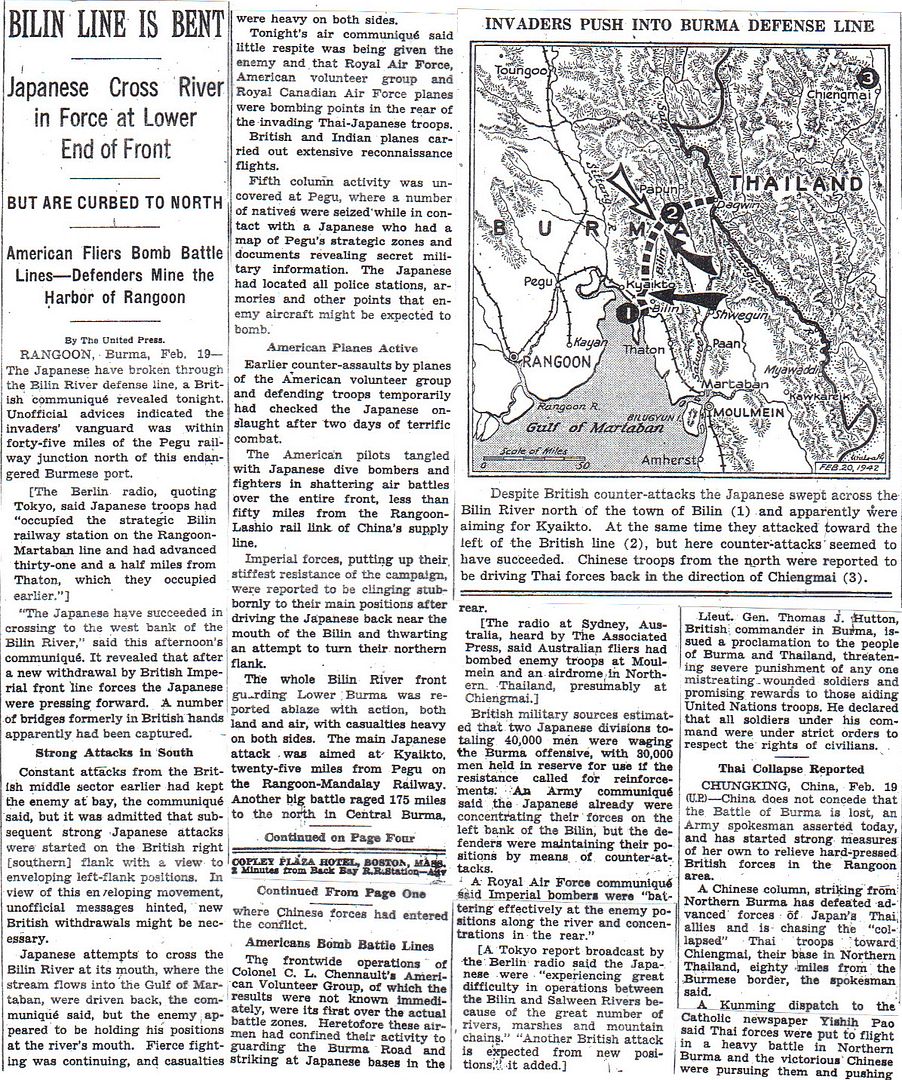
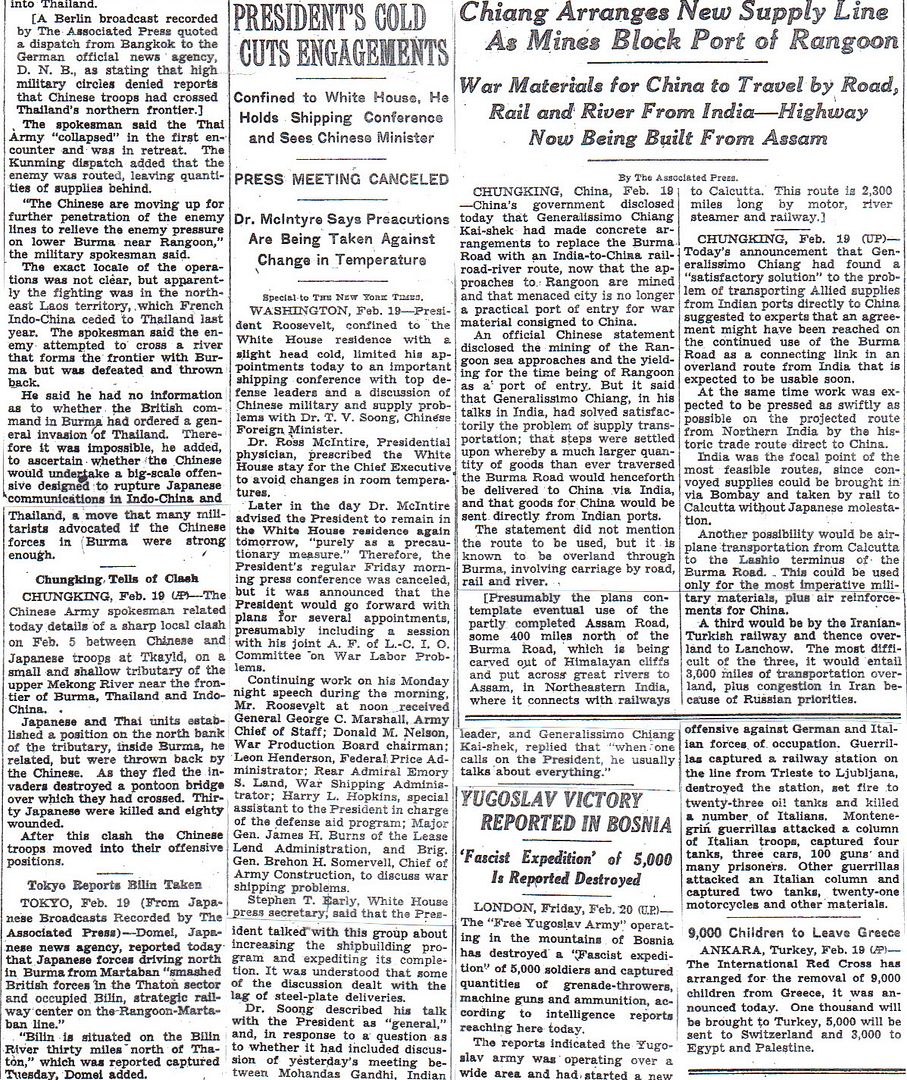

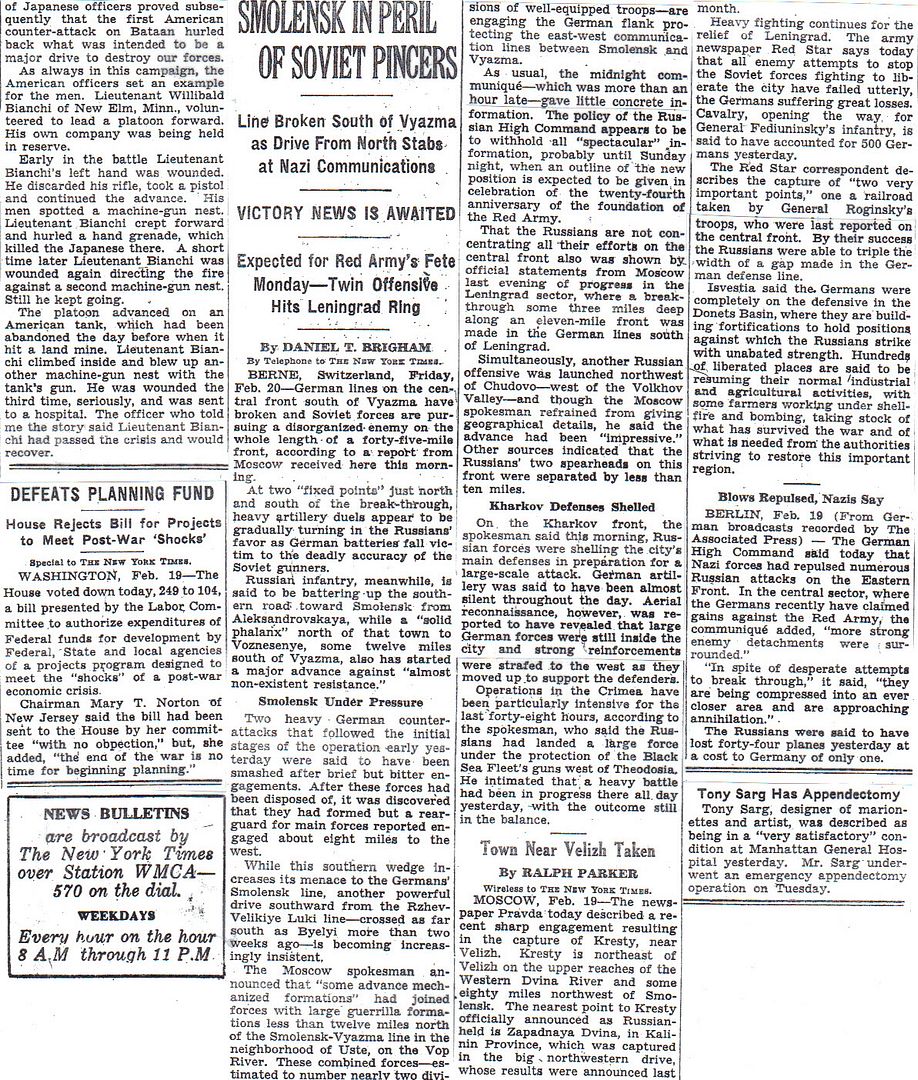
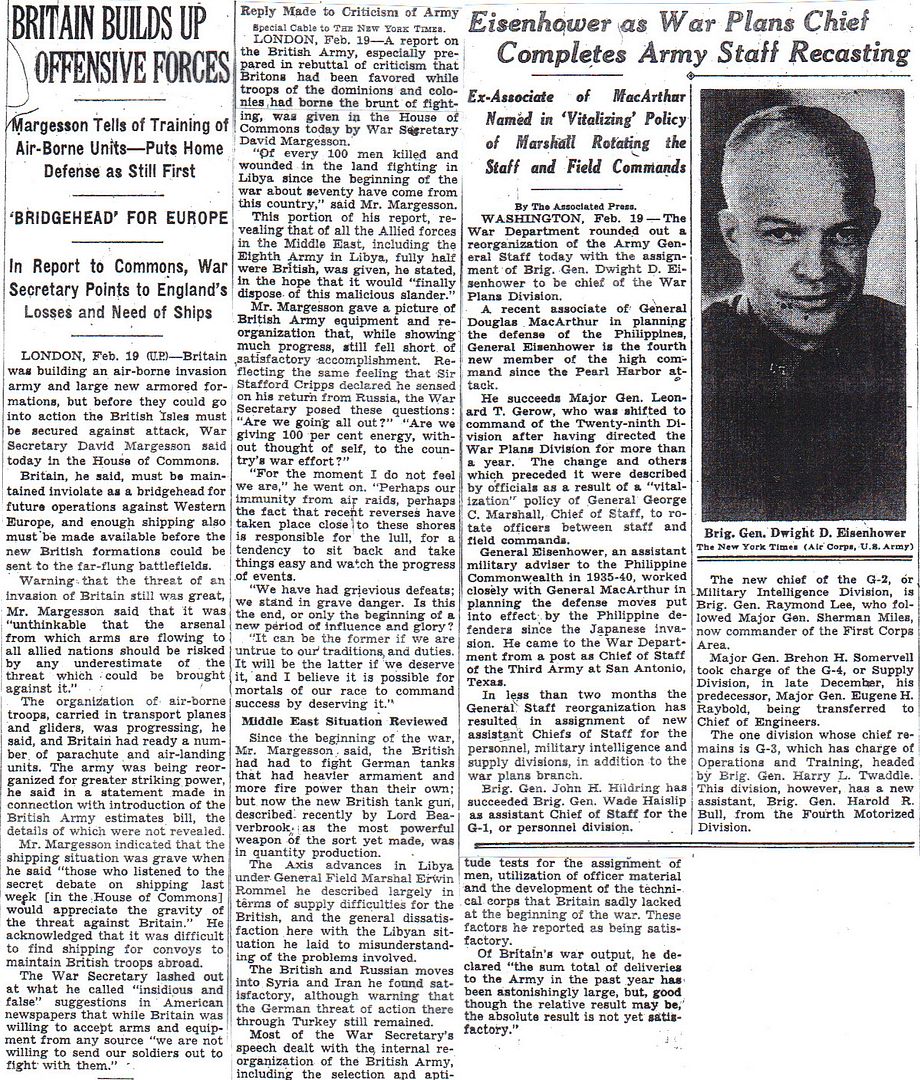
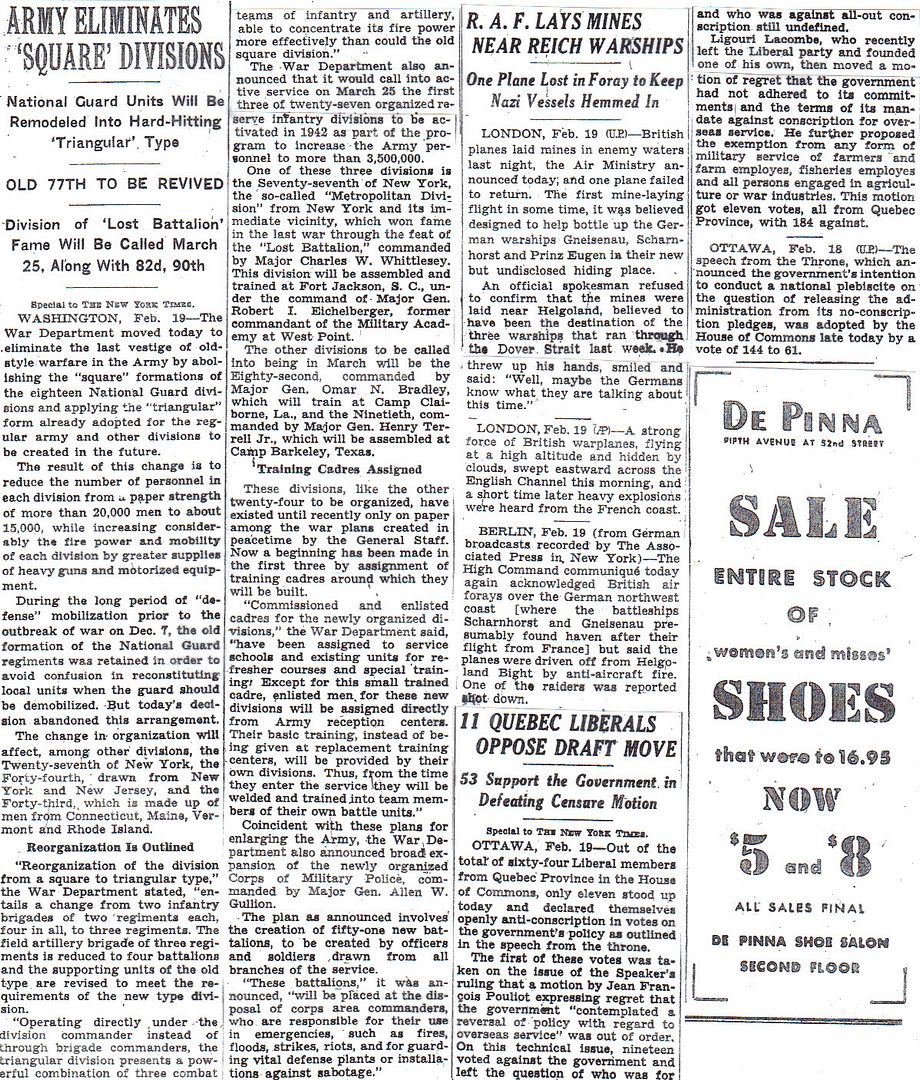
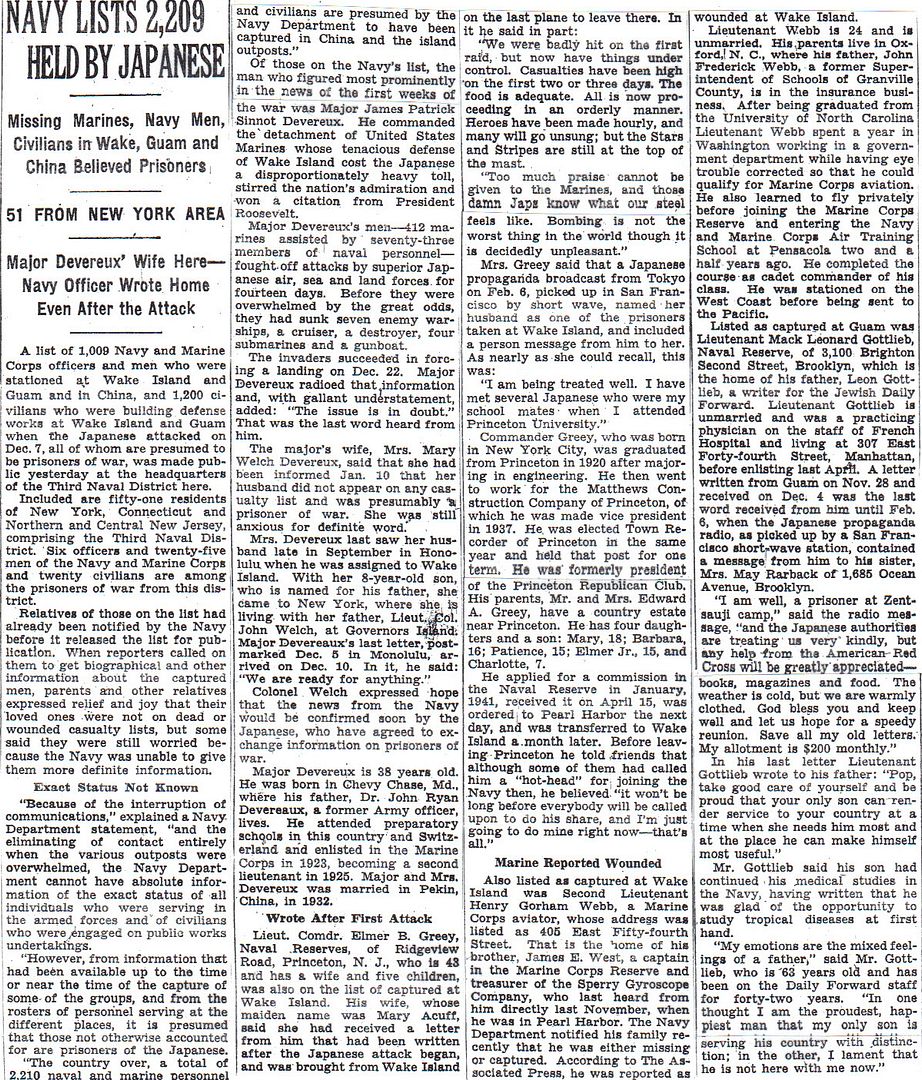
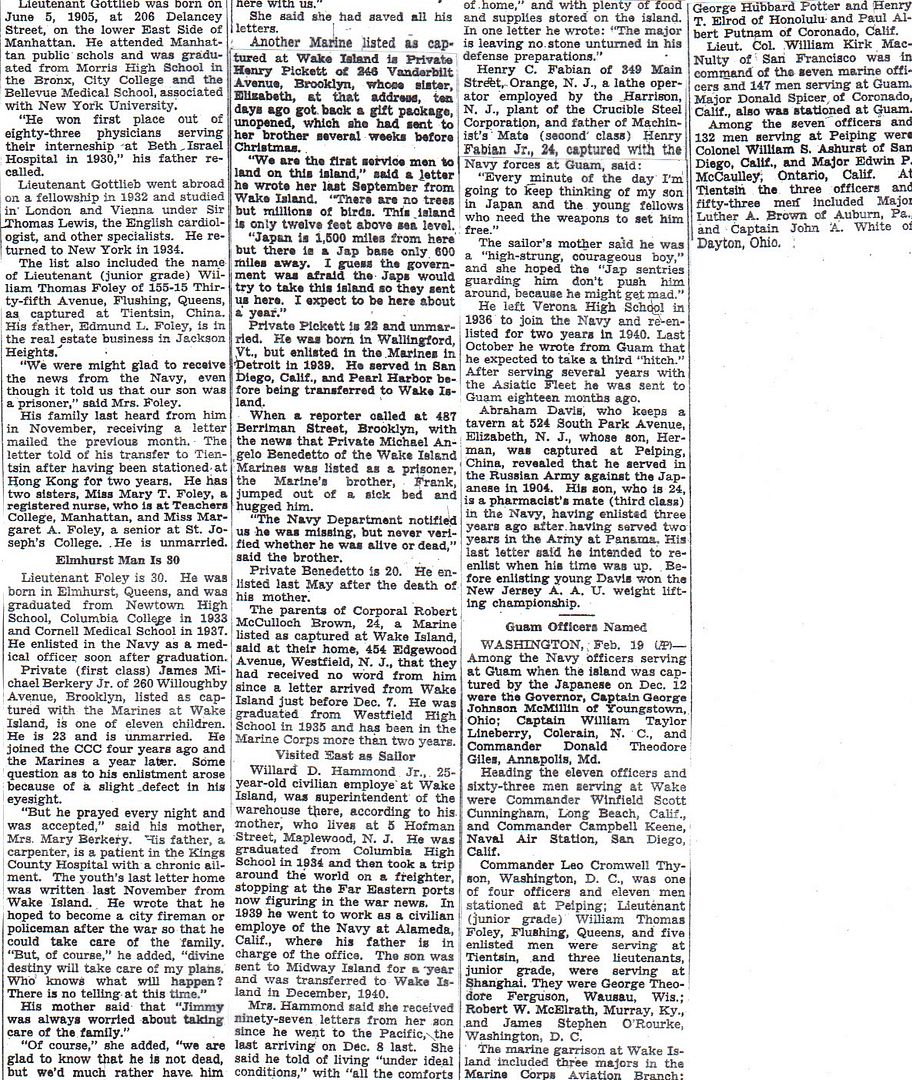
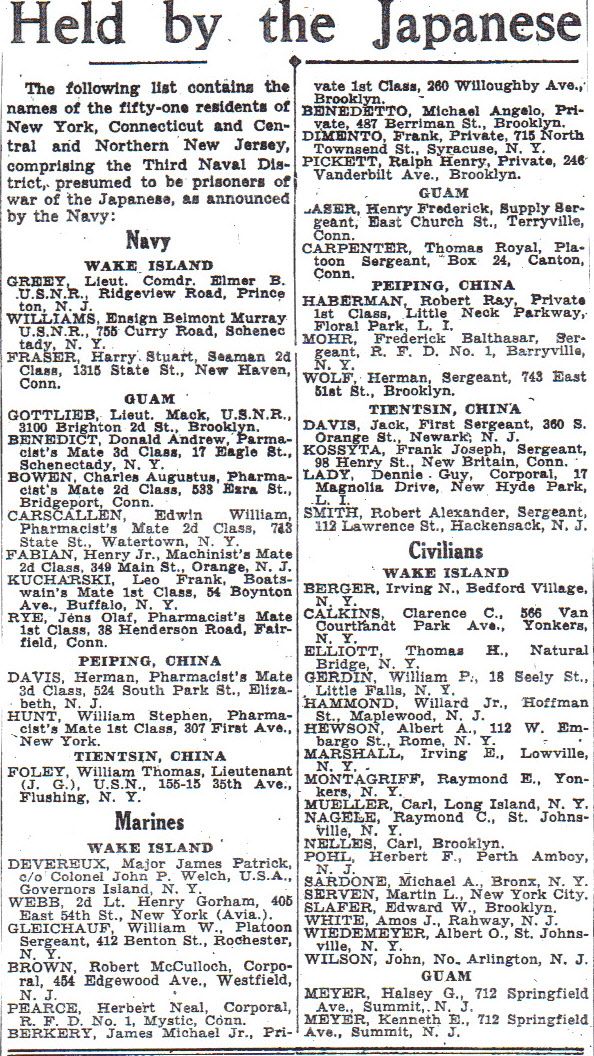
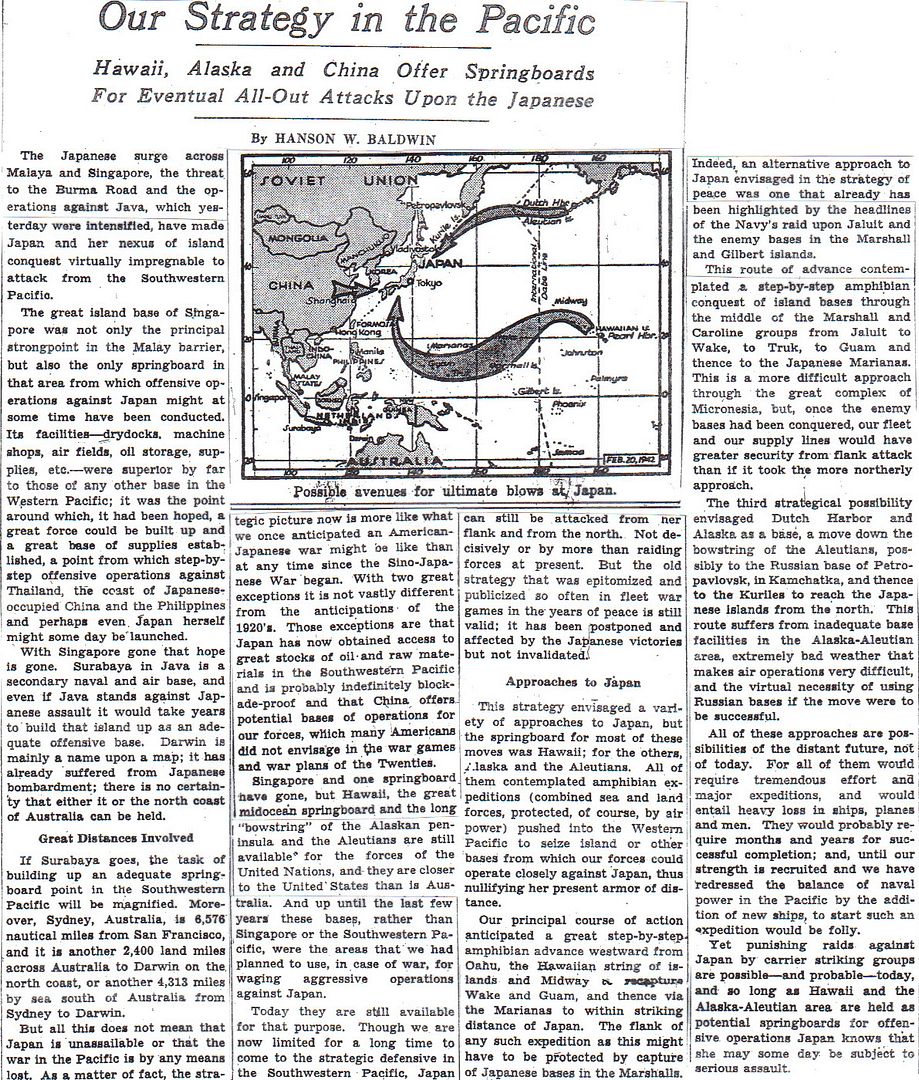
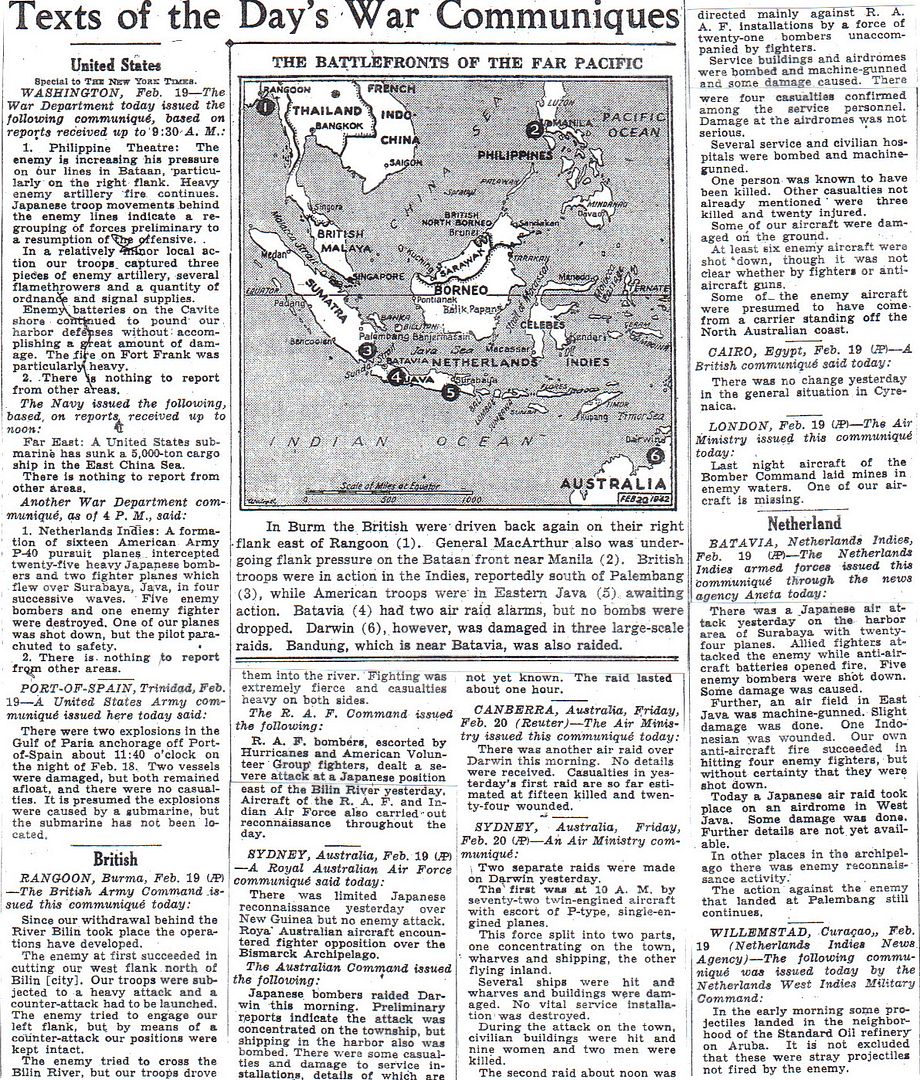
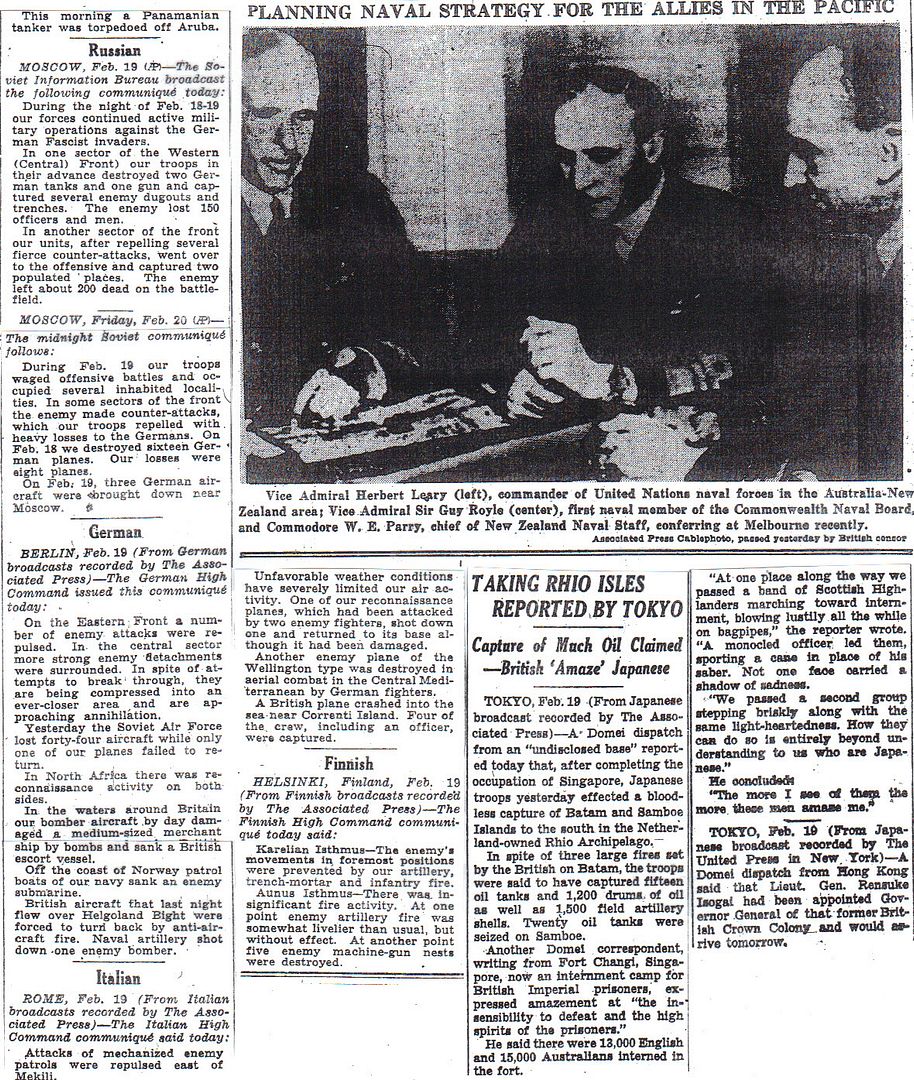
http://www.onwar.com/chrono/1942/feb42/f20feb42.htm
Japanese ward off US naval task force
Friday, February 20, 1942 www.onwar.com
In the Bismark Archipelago... Japanese drive off a carrier based task force led by the American aircraft carrier Lexington which attempts to attack Rabaul.
In Portuguese Timor... Japanese forces invade.
http://homepage.ntlworld.com/andrew.etherington/month/thismonth/20.htm
February 20th, 1942
UNITED KINGDOM: Major General Ira C. Eaker, who is to command the USAAF VIII Bomber Command, 8th Air Force, arrives by air with six staff officers to select a headquarters site and prepare for the arrival of American troops; he reports to Major General James E. Chaney, Commanding General U.S. Army Forces, British Isles (USAFI). (Jack McKillop)
Destroyer HNLMS Van Galen commissioned.
Escort carrier HMS Searcher laid down. (Dave Shirlaw)
FRANCE: Admiral William D. Leahy writes to President Roosevelt that he expects a recall “for consultation” since the French have not responded positively to Roosevelt’s message of 11 February. President Roosevelt, while sympathetic to Admiral Leahy’s position, subsequently informs his ambassador to Vichy that “to hold the fort [in Vichy] is as important a military task as any other in these days.” Leahy is thus retained in France. On the same day that Leahy writes to the President, however, German submarine U-156 puts in to the French island of Martinique in the Caribbean to put ashore one of the men wounded by the premature barrel explosion on 16 February.
GERMANY: Berlin: German casualties in the USSR so far are 199,448 dead, 708,351 wounded, 44,342 missing and 112,627 cases of severe frostbite.
The German naval warships, Admiral Scheer and Prinz Eugen leave Brünsbuttel for Norway. (Alex Gordon)
U-618 launched.
U-534, U-956 laid down. (Dave Shirlaw)
BURMA: The Indian 17th Division begins withdrawal behind the Sittang River, the 48th Brigade leading. (Jack McKillop)
NETHERLANDS EAST INDIES: Jakarta: With its latest simultaneous strikes the Japanese Pacific offensive now threatens Java and Australia’s northern doorstep. Landings were made yesterday on Timor, and Bali has been invaded today when Japanese aircraft of the Tainan Air Group land at the intact den Passar Airfield and begin operations. The Bali landings open the way for an assault on Java, separated from Bali only by two-mile-wide straits. With the capture by paratroops of the airfield at Kupang, on Portugese Timor, the Japanese now have a base within 500 miles of Australia. The Bali landings were opposed by Allied ships that damaged three enemy warships at the cost of two of their own damaged.
The Japanese land at Dili in Portugese (East) Timor during the night of the 18-19th. In December 1941, 155 Australian troops of the of the 2/2 Independent Company and 260 Dutch troops had landed at Dili. One Australian platoon was at Dili Airfield. By daylight, the Japanese had occupied part of the airfield and forced the Australians to retreat. In one incident four Australian prisoners had been forced to march some distance with their hands tied behind their backs, pushed into a drainage ditch beside the road and shot. Three were killed and when the survivor moved he was bayoneted. When he again regained conscientiousness, he found his hands free and wristwatch gone. He crawled away and was found by local natives who returned him to Australian lines. (Jack McKillop)
The Japanese also landed at Koepang in Dutch (West Timor) in the early morning. The Australian Imperial Force 2/40th Battalion and a coast artillery battery had been deployed to West Timor in December to defend the Bay of Koepang and Penfoie Airdrome. Japanese aircraft attacked Penfui Airfield and then dropped paratroopers of the Yokosuka 3rd Special Naval Landing Force to capture it. Again, the Japanese outnumbered the Allied forces and overwhelmed them. (Jack McKillop)
On Java, three Australian battalions, designated “Blackforce,” are tasked with defending five airfields. The destroyer USS Stewart (DD-224), damaged by shellfire in the Battle of Badoeng Strait the previous night, suffers further damage when, improperly shored and placed on blocks, she rolls on her port side in a Dutch floating drydock at Surabaya. (Jack McKillop)
During the morning, USAAF 5th Air Force aircraft based in Java attack the Japanese transports landing troops on Bali. B-17 Flying Fortresses attack in three waves and 17 A-24 Dauntlesses, escorted by 16 P-40s, attack six ships in Lombok Strait; they claim five hits on a cruiser (there were none) with the loss of two A-24s. Two P-40s are also shot down and three others are lost when they run out of fuel or crashing on landing. Late in the morning, five Japanese fighters based on den Pasar Airdrome on Bali attack Singosari Airdrome on Java and destroy three of five B-17s waiting to takeoff. (Jack McKillop)
PACIFIC OCEAN: The carrier, USS Lexington attacks Rabaul, New Britain. Note: While she tried to attack Rabaul, she encountered aerial resistance and abandoned the attempt. (Tim Lanzendoerfer)
Task Force 11 (TF 11) built around USS Lexington (CV-2), with Carrier Air Group Three (CVG-3) aboard, is attacked by Japanese Navy land-based aircraft as it approaches Rabaul on New Britain Island. Because of these attacks, the proposed mission against Rabaul is cancelled and TF11 begins withdrawing. Fighting Squadron Three (VF-3), equipped with Grumman F4F Wildcats, has a busy day: Between 1112 and 1202 hours, VF-3 pilots shoot down two four-engined patrol bombers.
At approximately 1700 hours, VF-3 pilots intercept nine Mitsubishi G4M Navy Type 1 Attack Bombers, Allied Code Name “Betty,” approaching the Lexington and shoot down four of them. The remaining five miss the carrier and flee. As the F4Fs chase the “Bettys,” another nine-plane element attacks the Lexington. Airborne at this time is Lt.(jg) Edward H. “Butch” O’Hare and he proceeds to shoot down five of the Bettys, and possibly a sixth, over Bougainville Island in the Solomons between 1705 and 1730 hours becoming the US’s first ace-in-a-day. O’Hare is subsequently awarded the Medal of Honor for this action. Other “Bettys” also attack and eight of nine are shot down by VF-3 pilots and the rear gunner in a Scouting Squadron Two (VS-2) Douglas SBD Dauntless. US casualties are two F4Fs and one pilot.
Although the US raid on Rabaul is cancelled, the loss of so many Japanese aircraft forces them to postpone the seizure of several positions in New Guinea. (Jack McKillop)
COMMONWEALTH OF THE PHILIPPINES: In Manila Bay area, the Japanese artillery bombardment of fortified islands reaches peak intensity. (Jack McKillop)
President Manuel L. Quezon has been evacuated on-board the submarine USS SWORDFISH (SS-193). He is accompanied by his wife and two children, Vice-President Sergio Osmeña, and other Philippine government officials off Mariveles. (Jack McKillop)
Quezon was carried to Mindanao and attempted to remain in the Philippines.
MacArthur quietly arranged for him to be kept under close escort as he did not trust Quezon not to try to cut a deal for neutralization of the Philippines with the Japanese. Quezon and Osmena were eventually carried to Australia and thence to the US. Quezon died in the US but Osmena went ashore at Leyte and resumed his duties as Philippine President as the US cleared the Archipelago.
Quezon’s reluctance in 1942 to leave the Philippines might have resulted from the knowledge that he was dying from tuberculosis and that he would have preferred to die on his home turf. In the event, he died, I believe, at Walter Reed hospital.
Off Bali, contact was made with two Japanese destroyers and a transport just past midnight on 19-20 by ABDA naval forces including the destroyers USS Parrott (DD-218) and the Piet Hein. The ensuing fight, left the Dutch destroyer Piet Hein at the bottom of the sea and the Japanese destroyer Michishio dead in the water. The USS Parrott struck ground in the treacherous shoal water, but was able to churn herself free and retire with the rest of the force to Surabaya.
AUSTRALIA: Canberra: A massive aerial onslaught by a Japanese naval task force yesterday shattered the northern Australian port of Darwin. Some of the 188 attacking aircraft were from four of the aircraft carriers that took part in the Pearl Harbor raid, plus land-based bombers operating from Celebes. The raid has temporarily wrecked Darwin’s war potential and has sunk many ships, including the USS PEARY, and killed 243 people. There was chaos and a little panic when the enemy action was interpreted as the prelude to an invasion. But this was clearly not the aim of the Japanese, whose apparent intention was to shatter the morale of Australia, which is fast becoming a rallying point against Japan’s expansion. (Associated Press)
In the wake of this strike Darwin is abandoned as an Allied naval base. RAF and USAAF air operations from the field outside the port, however, will continue. (Jack McKillop)
CANADA: Corvette HMCS Moose Jaw arrived St John’s for temporary repairs. (Dave Shirlaw)
U.S.A.: The Combined Chiefs of Staff announces that Allied forces on Java will not be evacuated under any circumstances. (Jack McKillop)
Washington: The US supplies the USSR with a $1,000 million loan.
Destroyers USS Hudson and Charrette laid down.
Destroyers USS Guest, Duncan, Hutchins and Lansdowne launched. (Dave Shirlaw)
CARIBBEAN SEA: U-156 puts into the French island of Martinique in the Caribbean to put ashore one of the men wounded by the premature barrel explosion on 16 February.
At 1131, the unescorted SS Delplata was hit by a single torpedo from U-156 about 60 miles west of Martinique. The torpedo struck on the starboard side aft of the #2 hold and damaged the superstructure, the wheelhouse, the chart room and the quarter of the master. The freighter took an immediate list to starboard, while the whistle cord become fouled and let the whistle blow continuously. Most of the ten officers, 30 men and 13 armed guards (the ship was armed with one 4in, four .50cal and four .30cal guns) abandoned ship in the four lifeboats and the three rafts. The master, seven crewmen and seven armed guards remained on board. One hour after the first hit, the U-boat fired a second torpedo, which struck on the starboard side and five minutes later another on the port side at the #2 hold. The gun crew fired twelve shot in the direction of the U-boat, but they had to left the ship as her heavy list to port increased. The next day, all men were picked up by seaplane tender USS Lapwing (AVP-1). Some of the crew returned to consider salvage possibilities and to recover belongings. The seaplane tender then sank the wreck by gunfire after it was determined that she could not be salvaged. (Jack McKillop and Dave Shirlaw)
ATLANTIC OCEAN: An unarmed U.S. freighter, the 5,529-ton Azalea City, of the Waterman Steamship Company heading from Trinidad to Philadelphia with a cargo of linseed, is torpedoed and sunk by German submarine U-432 about 125 miles (201 kilometres) east-southeast of Ocean City, Maryland. There are no survivors from the 38-man crew. (Jack McKillop)
At 0359, SS Nordvangen was hit in the stern by one torpedo from U-129 and sank within one minute. 19 Norwegian, four Dutch and one Danish crewmember were lost. The ship had been reported missing, but on 6 March, a marked lifeboat and some debris was washed ashore at Trinidad.
U-869 sunk due to unknown causes. The most probable cause is that one of its own homing torpedoes locked in on the boat itself after being fired on some unknown target. 56 dead (all hands lost). Several divers found a German U-boat off the coast of New Jersey, USA on 2 Sept 1991. On 31 August 1997 these same divers reported evidence that the boat they found is the U-869 (knife inscribed with a U-869 crewmember’s name, UZO torpedo aiming device, machinery-numbers from the engine room). This location is at 39.33N, 73.20W in about 230 feet of water.
The unescorted MS Lake Osweya followed three miles behind the Empire Seal, while they approached Halifax. When the British ship was sunk by U-96 at 2329 hours, the Lake Osweya tried to escape by changing course and zigzagging. But at 0453 on 20 February, the vessel was struck amidships by one torpedo fired by U-96 from a distance of 500 yards, broke in two and sank quickly by the bow. Lehmann-Willenbrock reported that three lifeboats were launched, but none of the eight officers, 22 crewmen and nine armed guards (the ship was armed with two 3in guns) were ever found. (Dave Shirlaw)
P6 mentions Lt. Willibauld Bianchi of New Elm, Minn in the Bataan fighting. Lt. Bianchi was one of three members of the Philippine Scouts to be awarded the Congressional Medal of Honor. Unfortunately, Lt. Bianchi died in captivity Jan 1945 when the unmarked Japanese “hell ship” he was being transported on was attacked and sunk by American aircraft.

I'm not sure that I'm buying this. In 5 minutes, the sub maneuvered from a position where it could torpedo the right side, to a position that it could hit the left side? Must have been one of those secret supersonic Nazi submarines.
If for no reason other than a freighter being hit by three torpedoes and not sinking.
Sounds like the basis for an excellent working relationship.
So we were still dealing with the unions while Churchill was getting things done.
Granted we are dealing with unions, but Churchill is having his fare share of problems as well. Despite the fact that the UK had the Ministry of Labor and National Service which as of July of 1940 could prohibit strikes, there are an ever increasing number of labor stoppages in World War II in England. It peaked in 1944 when there were a total of 2,194 labor stoppages equating to over 3.69 million man days lost.
This is not to say that the US didn’t have strikes too. In comparison, in 1943, the US had 3,800 stoppages and 13.5 million man days lost, but remember they also had a significantly larger labor pool. And, thanks to that amendment tacked onto the Selective Service Bill (now Law), the US government can take over any company or facility whose strike is detrimental to war production. John L. Lewis who you should remember from last year will get stung by this in 1943 when he calls for coal mine strikes four times and all four times the U.S. government took over the mines.
bump
but a lot of that “hasn’t happened yet” heh
Very true. All in good time of course.
Disclaimer: Opinions posted on Free Republic are those of the individual posters and do not necessarily represent the opinion of Free Republic or its management. All materials posted herein are protected by copyright law and the exemption for fair use of copyrighted works.